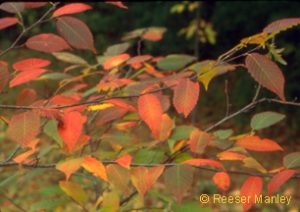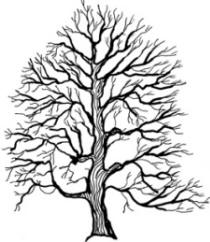Bulletin #2568, Native Trees and Shrubs for Maine Landscapes: American Hornbeam (Carpinus caroliniana)
Developed by Marjorie Peronto, Associate Extension Professor, University of Maine Cooperative Extension; and Reeser C. Manley, Assistant Professor of Horticulture, University of Maine.
For information about UMaine Extension programs and resources, visit extension.umaine.edu.
Find more of our publications and books at extension.umaine.edu/publications/.
Go native!
This series of publications is the result of a five-year research project that evaluated the adaptability of a variety of native trees and shrubs to the stresses of urban and residential landscapes in Maine. Non-native invasive plants pose a serious threat to Maine’s biodiversity. Plants such as Japanese barberry, shrubby honeysuckle, and Asiatic bittersweet, originally introduced for their ornamental features, have escaped from our landscapes, colonizing natural areas and displacing native plants and animals. By landscaping with native plants, we can create vegetation corridors that link fragmented wild areas, providing food and shelter for the native wildlife that is an integral part of our ecosystem. Your landscape choices can have an impact on the environment that goes far beyond your property lines.
Description

Form: a tree with a rounded canopy with horizontal, picturesque, slightly pendulous branches and fine texture; often low-branched or multi-trunked
Size: 35 to 50 feet high and wide
Ornamental characteristics:
- smooth, dark gray bark, fluted like sinewy muscle
- yellow, orange, and deep red fall foliage
Landscape Use
Because of its tolerance for both sun and shade, American hornbeam offers us a choice in terms of landscape use. You can use it as a relatively large understory tree in the woodland landscape, growing with native associates such as American beech (Fagus grandifolia), witchhazel (Hamamelis virginiana), pagoda dogwood (Cornus alternifolia), and shadblow serviceberry (Amelanchier canadensis). In this setting, expect hornbeam to acquire a more open and perhaps less symmetrical habit than it does in full sun.
Carpinus caroliniana can also be an excellent small shade tree in intimate landscape sites. Provided adequate moisture, hornbeam will thrive in full sun and be more dense and symmetrical than in shade. The orange to reddish green color of new foliage in spring is also more noticeable in sun.
American hornbeam is sensitive to drought, heat, and soil compaction. Plant it where soil moisture can be maintained with mulching and supplemental irrigation during summer drought, and away from the “heat island effect” of paving and building walls.
Culture

Hardiness: USDA zone 2
Soil requirements: prefers deep, rich, moist, slightly acid soils
Light requirements: full sun or shade
Stress tolerances:
soil compaction — intolerant
pollution — intolerant
deicing salts — intolerant
urban heat islands — intolerant
drought — intolerant
seasonal flooding — intolerant
Insect and disease problems: infrequent
Wildlife Value
The wildlife value of American hornbeam is considered to be generally low. However, the catkins are occasionally eaten by ruffed grouse, ring-necked pheasants, and quail. The nutlets are eaten by these birds as well as by yellow-rumped warblers and by foxes and squirrels.
Maintenance
Irrigation: During the establishment period, defined as one year after planting for each inch of trunk diameter at planting time, water your trees regularly during the growing season. Give the root zone of each tree 1 inch of water per week; in general, a tree’s root zone extends twice as wide as its canopy. After the establishment period, provide supplemental irrigation during periods of severe drought.
Fertilization: Landscape trees and shrubs should not be fertilized unless a soil test indicates a need. Correct soil pH, if necessary, by amending the backfill soil. No nitrogen fertilizer should be added at planting or during the first growing season.
To learn more about native woody plants
Visit the Eastern Maine Native Plant Arboretum at University of Maine Cooperative Extension’s Penobscot County office, 307 Maine Avenue in Bangor. Established in 2004, the arboretum displays 24 different native tree and shrub species that can be used in managed landscapes.
Reviewed by Cathy Neal, Extension professor, University of New Hampshire Cooperative Extension.
Photos by Reeser C. Manley.
Illustration by Margery Read, Extension master gardener.
This series of publications and the associated research were made possible in part by the Maine Forest Service’s Project Canopy.
Information in this publication is provided purely for educational purposes. No responsibility is assumed for any problems associated with the use of products or services mentioned. No endorsement of products or companies is intended, nor is criticism of unnamed products or companies implied.
© 2008
Call 800.287.0274 (in Maine), or 207.581.3188, for information on publications and program offerings from University of Maine Cooperative Extension, or visit extension.umaine.edu.
The University of Maine is an EEO/AA employer, and does not discriminate on the grounds of race, color, religion, sex, sexual orientation, transgender status, gender expression, national origin, citizenship status, age, disability, genetic information or veteran’s status in employment, education, and all other programs and activities. The following person has been designated to handle inquiries regarding non-discrimination policies: Director of Equal Opportunity, 101 North Stevens Hall, University of Maine, Orono, ME 04469-5754, 207.581.1226, TTY 711 (Maine Relay System).


